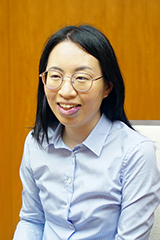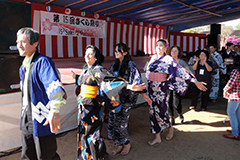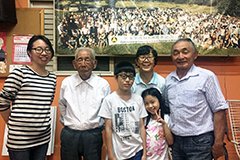Interview with Research Fellow Nagamura Yukako: Unraveling the Current State of Japan Through Japanese Emigration History
2021.10.07
About 100 years ago, there were people who left Japan to build a new life overseas. The fact that such emigration once took place may sound rather unfamiliar for many Japanese people today. Yet this is something closely related to modern Japanese society. We interviewed Nagamura Yukako, who joined in September 2020 as the first research fellow to work on Japanese emigration history at the JICA Ogata Sadako Research Institute for Peace and Development (JICA Ogata Research Institute), to ask about the newly launched research project on Japanese emigration history and its significance.

—What first made you want to study Japanese emigration history?
I first became interested in Brazil from a simple reason: bossa nova sounded so cool. This led me to major in Portuguese as an undergraduate. During that time, I joined the overseas study program to study at a university in Southern Brazil and was shocked by the diversity of the people living there, as there were many Italian or German immigrants and their descendants in the area. There were also many people with Japanese family roots and out of interest, I wondered why Japanese communities exist in Brazil. I think this was what first led me to my current studies.
After graduation, I became a journalist for Jornal do Nikkey, a Japanese newspaper published in Sao Paulo, Brazil. As I visited different Japanese communities around the country making interviews, I felt that I wanted to do more than just writing news articles every day and study further, so I joined a graduate school in Brazil. Being able to study how the history of Japanese immigration was viewed in Brazil from a purely local perspective, meant so much. Nevertheless, a lot of academic findings have also been accumulated in Japan, the country that had originally sent these people out, because of the ease to access publications written in Japanese. Therefore, as the next step, I wanted to further continue my studies at a graduate school in Japan, so I went on to study International Relations at Sophia University. In September 2020, I joined the JICA Ogata Research Institute, while working on my PhD.
—Please tell us about the research project you recently launched.
I am the chief of the study on the international migration and networks of Japanese descendants between Japan and Latin America. The advantage of this project is the ability to delve into migrant issues from multiple perspectives with a team of nine external researchers from various fields of expertise. For instance, while I am working on Japanese emigration history from a sociologist’s perspective, the team has historians, scholars specializing in the challenges confronted by modern immigrants, and those who themselves are Nikkei (descendants of those who emigrated from Japan) as well. The research theme is to approach issues around modern Japanese society from perspectives of Japanese emigration history with such diverse group members.

Sakura Festival held in a Nikkei settlement in Santa Catarina State
Around 300,000 Japanese people moved to Latin America before and after World War II. As they settled and started to have families, Japanese diaspora communities emerged across the region. When the 1990 amendment of the Immigration Control and Refugee Recognition Act of Japan enabled first to third generation immigrants to obtain Japanese working visas, the number of "dekasegi" workers, that is, Nikkei coming to Japan for temporary employment, increased. At the time, the asset price bubble was causing labor force shortage in Japan, and the government was hoping to address this issue with these workers. Since then, these workers have been facing many issues including those on working environment, child education, the rights of foreign citizens living in Japan and identity issues of fourth and fifth generations who were born and raised in Japan. These are all closely related to the state of modern Japanese society.
This is actually the first time for JICA Ogata Research Institute to conduct studies on Japanese emigration history. Research Fellow Facundo Garasino has also launched a separate research project on emigrants at the institute and each project has around ten researchers involved. This means that large-scale research activities on emigrants are now moving forward at once here. We are planning to put together the outcomes into books, as well as releasing academic papers.
—Please tell us about your research methods.
Methods can roughly be categorized into two types: studies using existing literature/documents; and personal interview surveys. Depending on each study, I use one of these two or combine both. The presentation on the outcomes of my studies under the theme “Infectious Diseases and Healthcare Experience in Emigration History: An Example Case in Emigrants from Japan to Brazil,” which I made at the 42nd Congress of the Japan Association for Latin American Studies in June 2021, is one example. Here, I looked at how disease transmission by immigrants became an emerging issue following the increase in the number of Japanese people traveling abroad before World War II. Obviously, real-time interviews were not possible. I therefore first did a research on documents on Japanese emigration programs of the time, including diplomatic records, and Japanese newspapers published in Nikkei communities, to investigate and analyze what kind of discussions on hygiene control and healthcare took place back then. Surviving documents such as newspaper articles are interesting: sections dedicated to letters to the editor and sections where journalists answer questions from readers already existed in Japanese newspapers of the time, for example. When you read these, you can understand the lifestyles of the Nikkei and have a glimpse of their ordinary daily lives, which administrative documents are never able to reveal on their own. On the contrary, if the subject of a study or anyone relevant is still alive, I conduct a face-to-face interview to record direct accounts. This is a method often known as oral history. Even though we collectively refer to these people as “international migrants” or “Nikkei” each person has a different life story, different experiences and different feelings. I think oral history is a really effective way to record such various lives.

Nagamura (left) posing for a photo with Yasunaga family from Promisson City (SP), who cooperated in her interview survey
—What is the significance of applying oral history?
Oral history interviews are different from ordinary interviews. They cannot be conducted unless there is trust between the subject and the investigator. In what context the subject talked or did not talk about within this specific relationship becomes extremely important. Therefore, relistening to the recordings of the interview afterwards is insufficient. There are findings you can make only after replaying the recordings several times.
Some are arguing in the academic world that oral history is too subjective and unscientific. However, I think that the truth is not exclusive to written accounts. To begin with, words recorded in documents often only represent the views of certain types of people: for example, those who had large voices within their communities; those of high social status; and men heading families in patriarchal communities. As we also need to understand the views of ordinary people, women, and those who were in vulnerable positions, I think oral history is essential for studies on migration history.
The identity of each Nikkei is completely different, depending on the difference of his/her background, including how many generations there are between the first-generation emigrants and him/her, and where he/she was born and brought up. I want to respect the experiences of each individual and each community these individuals belong to. The best part of this work is how we can reveal history that cannot be seen through frameworks established by the government, like visa types, and/or is unwritten.
—How would you like to give back to Japanese society with your research on Japanese emigration history?
Today, many foreigners live in Japan and are closely related to our lives. 30 years have passed since the amendment of the Immigration Control and Refugee Recognition Act, and even when we only look at Nikkei entering Japan, their identities are becoming increasingly complicated and multilayered. How can we make it easier for foreigners and Nikkei to live in Japan? We must understand how multiple cultures can co-thrive. I believe that perspectives of emigration history studies can be leveraged in addressing the various issues around Japanese society.
Furthermore, our project also collaborates with the Japanese Overseas Migration Museum in Yokohama. We would like to reflect our findings there as well. This museum widely disseminates information on Japanese emigration history and will be celebrating its 20th anniversary in 2022. Right now, based on our findings, we are updating and modernizing the contents of the permanent exhibition, and together with colleague researchers of this project, we are planning lectures for the general public to facilitate understanding on other cultures. There are limits to what I can do on my own, but by repeatedly discussing with researchers of different fields of expertise and/or different geographical regions, I hope we can deepen our understandings on the history of Japanese emigrants. Moreover, rather than keeping the outcomes exclusive to academia, I would like to disseminate them widely to the general public.
■ Profile
Nagamura is a research fellow at JICA Ogata Research Institute since April 2021. She joined the institute as a research assistant in September 2020. She is also a part-time lecturer at Kanda University of International Studies. Her previous roles include postdoctoral fellow at Sophia University, research fellow (DC2) of the Japan Society for the Promotion of Science (JSPS), coordinator of support for foreigners at Ibaraki NPO Center COMMONS, and journalist for Jornal do Nikkey. Nagamura holds a PhD (International Relations) from Sophia University, Japan. She also holds an MA (Sociology) from the Federal University of Parana, Brazil.

事業事前評価表(地球規模課題対応国際科学技術協力(SATREPS)).国際協力機構 地球環境部 . 防災第一チーム. 1.案件名.国 名: フィリピン共和国.

事業事前評価表(地球規模課題対応国際科学技術協力(SATREPS)).国際協力機構 地球環境部 . 防災第一チーム. 1.案件名.国 名: フィリピン共和国.

事業事前評価表(地球規模課題対応国際科学技術協力(SATREPS)).国際協力機構 地球環境部 . 防災第一チーム. 1.案件名.国 名: フィリピン共和国.

事業事前評価表(地球規模課題対応国際科学技術協力(SATREPS)).国際協力機構 地球環境部 . 防災第一チーム. 1.案件名.国 名: フィリピン共和国.

事業事前評価表(地球規模課題対応国際科学技術協力(SATREPS)).国際協力機構 地球環境部 . 防災第一チーム. 1.案件名.国 名: フィリピン共和国.
scroll